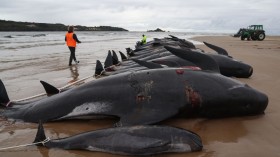Environmentally friendly hydrogen fuel could be generated with the help of a protein found in the membranes of microorganisms living in desert salt flats, according to a new study by the U.S. Department of Energy's Argonne National Laboratory.
Elena Rozhkova, a nanoscientist at the Argonne lab, combined semiconducting nanoparticles with bacteriorhodopsin -- a microorganism responsible for the unusual purple color in a number of salt flats in California and Nevada -- to create a system that uses light to spark a catalytic process that creates hydrogen fuel.
Titanium dioxide nanoparticles were chosen for the experiment because they have a known history of positive results in light-based reactions. As early as the 1970s, researchers were aware that when a titanium dioxide electrode was exposed to bright ultraviolet light it could split water molecules -- a phenomena known as the Honda-Fujishima effect.
Moving forward from the early experiments, researchers attempted to break further ground with work on titanium dioxide, attempting to extend the substance's reactivity to light in the visible spectrum.
"Titanium dioxide alone reacts with ultraviolet light, but not with visible light, so we used biological photoreactive molecules as a building block to create a hybrid system that could use visible light efficiently," Rozhkova said.
Rozhkova and her colleagues focused their experiment around bacteriorhodopsin because it is known to use sunlight as an energy source that allows it to act as a "proton pump" -- effectively straddling a cellular membrane and transferring protons from inside the cell to the extracellular space. In the researcher' hybrid system, the protons "pumped" out by the bacteriorhodopsin can be combined with free electrons of platinum within the titanium dioxide nanoparticles, which then produces hydrogen molecules.
"It is interesting that in biology, bacteriorhodopsin does not naturally participate in these kind of reactions," Rozhkova said. "Its natural function really doesn't have much to do at all with creating hydrogen. But as part of this hybrid, it helps make hydrogen under white light and at environmentally friendly conditions."
The virtually infinite nature of salt water and sunlight sets this hybrid system apart from other similar systems in hydrogen generation, the researchers report, suggesting their bio-assisted hybrid photocatalyst could be a good candidate for future green energy production systems.
Rozhkova and her colleagues' work is published in the journal Nano Letters.
© 2024 NatureWorldNews.com All rights reserved. Do not reproduce without permission.





